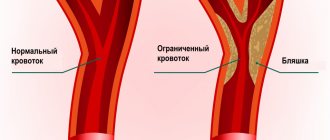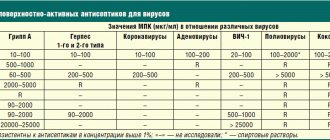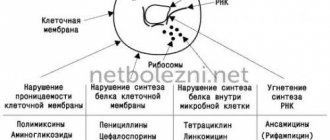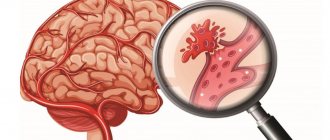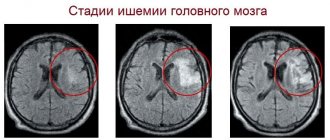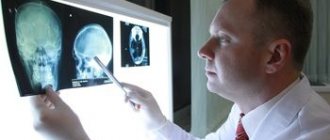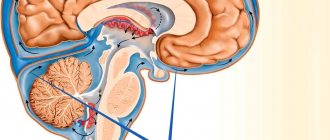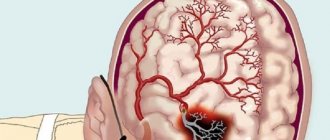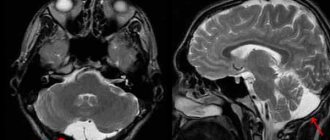Drugs that improve cerebral blood supply in cervical osteochondrosis can help get rid of the signs of pathology. Many medications are used to improve well-being. Each category has its own characteristics, so it is recommended to seek advice from a specialist before starting treatment.
Who may need vascular medications?
In early childhood, changes in blood flow in the brain are a consequence of perinatal encephalopathy, birth trauma, hypoxia during childbirth, and pressure drop during cesarean section. If a treatment plan is drawn up correctly, the child’s condition will normalize within 2-3 years. If the baby has cerebral palsy and other serious diseases, he will have to take vascular medications for the rest of his life.
School-age children grow quickly, and vascular medications may be needed due to the increased workload.
In adults, cerebral circulatory disorders are even more common - due to heart disease, osteochondrosis, ischemia, thrombosis, injuries, and operations.
In older people, the blood vessels of the brain suffer from atherosclerosis - blockage of the arteries with plaques. All of these categories of patients have indications for taking vascular drugs.
Drug treatment for stroke
A stroke is an acute circulatory disorder in the brain that requires quick help and further long-term treatment. Correctly selected drugs will help save the patient’s life and increase the chances of restoring lost functions (speech, motor).
In an ischemic stroke, part of the brain is deprived of blood supply due to a blood clot formed in a vessel. The following drugs are indicated for patients with this disease:
- At the first signs of acute stroke, antiplatelet drugs are prescribed. The most famous of them is aspirin. In case of intolerance, replace it with Ticlopedine, Dipyridamole.
- To prevent the formation of blood clots and blockage of blood vessels, low-molecular-weight heparins, for example Clexane, are indicated.
- After heparins, treatment with indirect anticoagulants (Sincumar, Warfarin) is continued.
- To increase blood volume and improve its flow to the brain, molecular dextrans (Reopoliglucin) are indicated.
- For high blood pressure, calcium channel blockers and ACE inhibitors are prescribed to prevent recurrent stroke.
- To improve microcirculation, Trental and Curantil are used. For vasodilation - Vinpocetine.
- During the recovery period, nootropic drugs are indicated.
Hemorrhagic stroke is caused by a ruptured blood vessel in the brain and requires different treatment. Often it is necessary to resort to surgical intervention. Drugs prescribed include dextrans to replenish blood volume and medications to lower blood pressure.
Calcium channel blockers
These medications are among the most popular among neurologists and therapists. Due to a decrease in the amount of calcium in cell membranes, the vascular walls relax, their lumen expands, and blood flow increases. The amount of nutrients and oxygen reaching the brain also increases. The tone of the veins does not change, which is important for maintaining normal venous outflow. There are a number of proven drugs, as well as new generation drugs.
Which ones are better to choose? The list of the most popular is given in the table.
| Generation | Name of medicine | Group |
| First | Verapamil | Phenylalkylamine derivatives |
| First | Nifedipine | Dihydropyridine derivatives |
| First | Diazem | Benzothiazepine derivatives |
| Second | Isradipin | Benzofurazanil derivatives |
| Second | Plendil | Dihydropyridine derivatives |
Currently, third-generation drugs are being developed that have even fewer side effects and contraindications. The above remedies can also treat arterial hypertension. Vasodilators are contraindicated during pregnancy and lactation.
Vasodilators
This is a large group of medications that are used to treat various diseases. Vasodilators dilate blood vessels and thereby improve the supply of blood, and therefore useful substances, to brain cells and the central nervous system. They stimulate cellular metabolism and energy metabolism, thereby increasing brain activity. They are also used as heart medications.
Calcium antagonists
They have a relaxing effect on the arteries, while the tone of the venous walls does not change. Calcium channel blockers have long been successfully used to treat cardiovascular pathologies. Today the third generation of these drugs is being produced.
Nifedipine is a drug for cerebral vasodilation from the group of calcium antagonists
First generation drugs include:
- Nifedipine,
- Delacor,
- Verapamil.
Second generation drugs:
- Felodipin,
- Klentiazem,
- Verapamil SR.
New generation drugs are represented by a group of dihydropyridines, including:
- Norvasc,
- Stamlo,
- Alodipine.
These medications should be taken with caution, as they can have a systemic effect on the body.
Alpha blockers
These drugs improve metabolism in tissues and blood flow in the vessels of the brain, and help with oxygen starvation, which developed as a result of vasospasm. These include Sermion and Nitsergoline derivatives.
Antispasmodics
They relax the smooth muscles of the vascular walls and expand the lumen of blood vessels. Antispasmodics are considered the mildest and safest of vasodilators, but they should be taken with caution by older people. The fact is that they practically do not work on vessels affected by atherosclerosis and redistribute blood in favor of healthy areas. Therefore, they are generally not suitable for older people. People in this age category are prescribed calcium channel blockers. The most commonly used antispasmodics are drotaverine hydrochloride and no-spa.
Antispasmodics are excellent for headaches caused by cerebral vasospasm
Combination drugs
They contain substances that have different actions. This group includes:
- Instenon - includes etomivan, etophylline, hexobendine.
- Vasobral - it contains caffeine and alphadihydroergocriptine.
Antioxidants and antihypoxants
Such medications are always prescribed as part of complex therapy to improve cerebral vascular function. They quickly eliminate the symptoms of oxygen starvation and help strengthen vascular walls. Here is a list of the best medicines:
- Actovegin
(630 rubles). Activates tissue metabolism, eliminates hypoxia, optimizes trophism and recovery processes. The drug is obtained from the blood of animals, therefore, in addition to allergies, it has a small number of side effects. - Mexidol
(470 rubles). It is one of the best antihypoxants, membrane protectors, and nootropics. The medicine is administered intramuscularly or taken in tablet form. It increases the body's resistance to various damaging factors. With long-term use, the medicine somewhat thins the blood and reduces the accumulation of lipids, lowering cholesterol. - Emoxipin
(250 rubles). Antioxidant, stabilizer of cell membranes, reduces vascular permeability. Has a retinoprotective effect. Most often prescribed if cerebral disorders affect the condition of the retina. - Glycine
(40 rubles). This amino acid is a natural brain metabolite, a neurotransmitter, that helps regulate metabolism in brain tissue.
Complamin, Glutamic acid, Picamilon and other antihypoxic and antioxidant agents also improve the functioning of cerebral vessels.
Products to improve blood circulation in the brain:
– amino acids of animal and plant origin (meat, legumes);
– seafood (mussels, shrimp) and sea fish (mackerel);
– vegetables and fruits high in vitamin C and group B;
– cereals, nuts, berries and citrus fruits (rich in bioflavonoids).
Drinking regime
– a separate item in the program for improving blood circulation in the brain. Research shows that sufficient water consumption (2.5 liters per day in the absence of additional instructions due to pathologies) is the prevention of blood clots. However, in case of pathologies, it is still necessary to use antiplatelet agents or anticoagulants prescribed by a doctor.
Thirst quenching is also necessary for the development of neural populations28,29. The latest research shows that molecular hydrogen in drinking water protects the brain from neurodegenerative changes of various origins, including those caused by traumatic brain injury30. Therefore, to improve blood supply to the brain, it is necessary to drink enough water, and the drinking regime should be regular - the recommended 2.5 liters must be evenly distributed throughout the entire waking period.
Please note that 2.5 liters is an average. According to research, women on average need to drink less water than men (2.2 liters and 3 liters per day, respectively)31. Also, the recommended daily amount of water is determined by weight, age and lifestyle32. Below is a table of recommended daily water intake.
Vitamins and minerals
The next group of vasodilator drugs for the brain are vitamin supplements that are urgently needed for the normal functioning of blood vessels. Most often, patients are recommended drugs based on nicotinic acid in injections.
The medicine improves the metabolism of nitrogenous substances and carbohydrates, dilates blood vessels, and reduces cholesterol. Nicotinic acid also improves blood microcirculation in the brain and replenishes vitamin B3 deficiency.
The main preparations with vitamins are Nicotinamide, Niacinamide, Nicotinic acid in ampoules.
Rutin is another remedy that strengthens blood vessels. Troxerutin and Ascorutin are made on its basis; they are prescribed against the fragility of small capillaries, to reduce the permeability of vascular walls, as an antioxidant.
Also, patients with vascular diseases are recommended to regularly take tablets with retinol, tocopherol, potassium, selenium, and silicon. For osteochondrosis of the neck and other diseases of the spine, a complex of B vitamins - Neuromultivit, Compligam, Milgamma - is always introduced into the course of therapy.
Improving blood circulation in the brain - diet and drinking regimen
A diet to improve blood circulation in the brain is selected based on the metabolic characteristics and condition of a particular person. Before adjusting the diet, it is recommended to conduct the following studies: daily blood pressure monitoring, blood tests for glucose and cholesterol, and a coagulogram. Based on research results, it is necessary to adjust the amount of salt, sugar, animal fat and other products in the diet24,25,26.
Diet recommendations to improve blood circulation in the brain:
– The consumption of salted, smoked and canned foods is usually limited in the presence of arterial hypertension, based on the recommendation - no more than 4.5 grams of salt per day.
– Restrictions on the amount of animal fat (fatty meat, lard, milk, butter) are determined by the presence of hypercholesterolemia, which sets the upper limit - 1 gram of fat per 1 kg of weight.
– The amount of monosaccharides and disaccharides (glucose, sucrose and foods high in them) is limited when blood glucose is high. In this case, preference is given to polysaccharides, which are found, for example, in durum cereals and pasta.
– Since vitamin K actively stimulates blood clotting, if this indicator increases, it is recommended to limit all foods high in vitamin K (white cabbage, broccoli, spinach, lettuce, soy, eggs, dairy products, green tea).
Research shows27 that foods high in sodium reduce central perfusion pressure, which measures the level of blood flow to the brain. In this regard, outside of pathologies, it is recommended to avoid excessive consumption of foods high in sodium - salt, herring, caviar, almost all cheeses, beef kidneys, feta cheese, dry cream, powdered eggs.
Nootropics
These medications do not act directly on blood vessels, but they improve overall metabolism in tissues, stabilize neurocyte membranes, increase tissue resistance to oxygen starvation, thereby optimizing blood supply to the brain. Nootropics are prescribed even to children, they are indicated for most elderly people, and are used in the complex treatment of osteochondrosis, atherosclerosis, hypertension, the consequences of cerebral palsy, etc.
The cheapest and most accessible are racetams - Piracetam, Nootropil, Lucetam, Phenotropil and others.
The latest generation of drugs includes Cortexin, which is a complex of polypeptides from the animal cerebral cortex. The medicine is injected into the muscle; it is available only in injection form. Price for 10 ampoules - 1300 rubles.
Patients are also given the following injections:
- Cerebrolysin;
- Vinpocetine;
- Cavinton;
- Telektol;
- Bravinton.
Many nootropics have a positive effect on blood composition - they prevent platelets from sticking together, improving blood microcirculation by increasing its fluidity. This helps to avoid thrombosis and other serious complications of vascular pathologies.
Choosing effective medications
To treat cervical osteochondrosis and normalize blood circulation, different groups of drugs are used:
- Muscle relaxants.
- NSAIDs are non-steroidal anti-inflammatory drugs.
- Chondroprotectors.
- Analgesics.
- Vasodilator medications.
- Vitamin complexes.
Drugs that improve cerebral circulation are of great importance. The functioning of the brain depends on this function, since it requires nutrients. Problems with blood supply inevitably lead to various conditions, the most dangerous of which is stroke.
Vasodilators are often prescribed during the development of cervical osteochondrosis and cerebrovascular accidents. These medications include drugs whose action is aimed at reducing the tone of smooth muscles. This leads to an increase in the lumen of blood vessels, so cerebral circulation improves. Thus, the effect of vasodilators is represented by the following features:
- smooth muscles have a relaxing effect;
- change in the sensitivity of nerve endings.
The use of this group of drugs leads to the following results:
- Elimination of stagnant processes occurring in the blood.
- Improving blood circulation in diseased joints and tissues.
- Restoring the functionality of nerve impulses.
Medicines for atherosclerosis
If a person is diagnosed with atherosclerosis, treatment with folk remedies or so-called vascular cleansing is not always enough. Atherosclerosis of cerebral vessels is a very serious disease; without treatment it leads to stroke.
The following will help improve blood circulation in this pathology:
- Statins
- Rosuvastatin, Atorvastatin, Lovastatin. Many people have to take these medications for several years; they normalize cholesterol levels and prevent it from depositing in the blood vessels. Unfortunately, statins have a bad effect on the liver and other internal organs and can cause a number of side effects. - Fibrates
- Fenofibrate, Clofibrate. They increase “good” cholesterol while reducing “bad” cholesterol. The course usually lasts up to 2 months, then take a break. - Other means - bile acid sequestrants
. These medications are Cholestyramine and Cholestipol. They bind the cholesterol present in the intestines and remove it, preventing it from being absorbed.
In mild cases of atherosclerosis, it is enough to take Omega-3 acids, which strengthen the walls of blood vessels and prevent the disease from progressing.
Additional funds
To normalize blood circulation and improve the well-being of a patient with cervical osteochondrosis, Pentoxifylline can be used. The drug copes well with spasms and prevents platelets from sticking together by thinning the blood. As a result of treatment, microcirculation of the areas that led to problems with cerebral circulation improves. However, Pentoxifylline has side effects, so be sure to consult a specialist before treatment.
Medicines that improve memory and blood circulation are very important in the treatment of cervical osteochondrosis. Piracetam has a positive effect. The medicine affects microcirculation and metabolic processes, resulting in their improvement. Piracetam does not have a psychostimulating or sedative effect. It helps restore not only the functioning of memory, but also speech, consciousness and mental performance.
Vinpocetine is a peripheral vasodilator. Increasing cerebral blood flow and metabolism is not the entire list of positive qualities of Vinpocetine. When treating the cervical spine, an increase in glucose and oxygen consumption is observed, the sensitivity of blood vessels decreases and resistance to the minimum oxygen content increases.
Vinpocetine has no effect on heart function and does not affect blood pressure. The result of therapy is an improvement in the rheological characteristics of blood - viscosity and fluidity. When treating the disease with Vinpocetine, metabolic processes improve and hypoxia does not develop. Vinpocetine should not be used alone for the treatment of cervical osteochondrosis, as improper use will lead to side effects:
- arrhythmias;
- headache;
- pressure surges.
The drug Cinnarizine also has another name - Stugeron. The use of the medicine causes the expansion of the lumen of blood vessels, which has a positive effect on blood circulation and the treatment of osteochondrosis. As a result of blood thinning under the influence of active components, blood flow improves. The medicine does not affect the functioning of the heart and other organs. Therefore, the patient's blood pressure remains normal. The main goal of treatment with Cinnarizine is to maintain the functionality of the nervous system. Side effects are rare, but it is recommended to visit a doctor and consult with him before starting the course.
During the treatment of osteochondrosis, combined treatment options and regimens can be used. Piracetam interacts well with Cinnarizine without causing side effects. The use of several drugs allows you to reduce the dosage while maintaining the therapeutic effect.
Other drugs
Often a person experiences vascular spasms (when taking vasoconstrictor medications, hypertension, smoking, etc.). In this case, antispasmodics will help improve blood flow - No-shpa, Revalgin, Drotaverine, Papaverine. Doctors also prescribe as vascular agents:
- antiplatelet agents (thin the blood) - Warfarin, Heparin, Aspirin;
- medicines with ginkgo biloba (increase blood supply to the brain) - Tanakan, Gingikum, Bilobil.
You cannot select treatment regimens on your own - it is important to make prescriptions taking into account the exact indications and type of disease, to know the contraindications, side effects and effectiveness of the active substances.
Drugs that reduce blood viscosity
Anticoagulants and antiplatelet agents improve blood fluidity and reduce its viscosity, which leads to normal blood supply to the brain.
Anticoagulants
This category of medicines includes the following drugs:
- Heparin,
- Warfarin,
- Fragmin,
- Clexane,
- Fraxiparine.
They improve microcirculation in blood vessels and reduce blood clotting. These drugs are taken under the supervision of a doctor. To prevent bleeding, blood is periodically donated for biochemistry.
Anticoagulants are used only under the supervision of a doctor and as prescribed.
You should immediately consult a doctor if, after taking anticoagulants, bruises on the body, black feces, or vomiting blood appear.
Antiplatelet agents
Antiplatelet agents reduce blood viscosity. They are indicated for those with a tendency to thrombosis and micro-strokes. They help prevent thromboembolism. In case of cerebrovascular accidents, they are prescribed only after examining the patient and studying the results of all his tests. This group includes:
- Aspirin,
- Chime,
- ThromboASS,
- Ticlopidine,
- Aspilat.
The best drugs for the blood vessels of the head
It is possible to resume the stable operation of the processes occurring in the organs of the central nervous system if you follow the exact instructions for natural medicinal products and modern vasodilating drugs.
- Actovegin
. Promotes oxygen saturation of tissues and organs, has an antioxidant effect, restores blood flow, and prevents the onset of ischemic stroke. Daily dosage: 1-3 capsules before meals 3 times. Intravenous administration involves 10-15 ml of the drug in combination with a 0.9% NaCl solution or 5% dextrose. - Vasobral
. Vasodilating drug. Reduces the permeability of the vascular wall, restores cerebral circulation, increases mental activity, reflex excitability of the spinal cord and increases the activity and stability of the brain. Eliminates attention, memory and vestibular complications. Prescribed 0.5 - 1 tablet in the morning and evening. In the form of a solution, it is recommended to take 2-4 ml twice a day. - Ceraxon
. The nootropic active ingredient promotes the restoration of cells and damaged tissues. Reduces the effects of memory loss, improves attention and thinking. For traumatic brain injuries and heart failure, it reduces the duration of associated symptoms. In the acute ischemic period, intravenous administration of 1000 ml is recommended.
CEREBRAL CIRCULATION INSUFFICIENCY OF VASCULAR GENESIS
Preferanskaya Nina Germanovna Associate Professor, Department of Pharmacology, Educational Department, Institute of Pharmacy and Translational Medicine, Multidisciplinary Center for Clinical and Medical Research, International School “Medicine of the Future”, First Moscow State Medical University. THEM. Sechenov (Sechenov University), Ph.D.
Divaza (tablet for resorption No. 100) is an innovative combination drug containing affinity-purified antibodies to the brain-specific protein S-100 and affinity-purified antibodies to endothelial NO synthase. Antibodies to the brain-specific protein S-100 have antioxidant, antihypoxic, neuroprotective, and anxiolytic effects. The combined use of the components of the drug is accompanied by an increase in the neuroprotective activity of antibodies to the S-100 protein, an increase in the vegetative-stabilizing effect, normalization of the vegetative status, a synergistic effect of both components on neuronal plasticity and, as a result, an increase in the brain’s resistance to toxic influences.
The use of the drug improves integrative activity and restores interhemispheric connections of the brain, helps eliminate cognitive impairment, stimulates reparative processes and accelerates the restoration of central nervous system functions, increases mental performance, restores learning and memory processes, normalizes somatovegetative manifestations, and increases cerebral blood flow. The drug does not have a sedative or muscle relaxant effect, and does not cause addiction or addiction.
Divaza is used to restore integrative brain activity in a wide range of organic disorders of the central nervous system caused by neurodegenerative, cerebrovascular diseases, neuroinfections, and traumatic brain injury. Used as part of complex therapy. Individual hypersensitivity reactions to the components of the drug are possible.
1 tablet of the drug contains affinity-purified antibodies to the brain-specific protein S-100 - 0.006 g and affinity-purified antibodies to endothelial NO synthase - 0.006 g.
Instenon is a combination drug containing etamivan, hexobendine and etophylline . The neuroprotective effect of the drug is based on mutual potentiation of effects. The drug selectively stimulates brain metabolism, stabilizes cerebral and systemic circulation, slows down the death of brain neuron cells, moderately dilates coronary and cerebral vessels, increases the utilization of glucose and oxygen by brain cells. When using the drug, performance increases, fatigue, headaches decrease, mood and general tone improve.
The drug is prescribed to patients with acute and chronic forms of vascular pathology of the brain, consequences of a stroke, 2 ml IM or IV, after dissolving it in 200 ml of 5% glucose, 1-2 times a day.
Use 1-2 tablets orally. 3 times a day, without chewing, if necessary, increase the dose to 5 tablets.
Available: table, cover. obol. (50 mg etamivan + 20 mg hexobendine dihydrochloride + 60 mg etophylline); table forte (100 mg etamivan + 60 mg hexobendine + 60 mg etophylline); solution for injection, amp. 2 ml (50, 10 and 100 mg respectively).
Important! The most common side effects are decreased blood pressure, headache, and short-term tachycardia.
Piracetam + Cinnarizine (“ Omaron ”, tab., “ Combitropil ”, caps., “ Pyracesin ”, caps.) is a combination drug ( piracetam 400 mg + cinnarizine 25 mg ). Both components mutually potentiate their actions: antihypoxic, reduce cerebral vascular resistance and improve cerebral metabolism, and contribute to a significant increase in cerebral blood flow. The combined drug is quickly and completely absorbed from the gastrointestinal tract. The therapeutic effect appears after 1–6 hours.
Indications for use are various cerebrovascular accidents; for the prevention of migraines, to improve learning and memory of children with intellectual retardation. The usual dose for adults is 1-2 caps. 3 times a day for 1–3 months, depending on the severity of the disease. Repeat the course 2-3 times a year. Children from 5 years of age are prescribed 1-2 capsules 1-2 times a day.
Vinpocetine + Nootropil ( Vinpotropil , capsule, tablet, coating, concentrate d/injection solution) is a combination drug ( vinpocetine 5 mg + piracetam 400 mg ). The action is due to the components included in the composition, the effect develops gradually. Vinpocetine is a vasodilator that improves cerebral circulation; as a cerebrovasodilator, it improves cerebral circulation, causes a slight decrease in systemic blood pressure, dilation of cerebral vessels, increased blood flow and improved supply of oxygen and glucose to the brain; increases the resistance of brain cells to hypoxia, facilitating oxygen transport.
Piracetam as a nootropic agent has a positive effect on the metabolic processes of the brain, increases the concentration of ACE in brain tissue, enhances the synthesis of RNA and phospholipids, stimulates glycolytic processes, enhances glucose utilization; improves the integrative function of the brain.
Adults and adolescents over 14 years of age are prescribed orally, before meals, 1-2 caps. 3 times a day. Maintenance dose - 1 capsule 3 times a day. The course of treatment is from 2–3 weeks to 2–6 months. Before discontinuing the drug, the dose is reduced gradually.
PREPARATIONS OF ANIMAL ORIGIN
Cerebrolysin (injection solution, 1, 5 and 10 ml, amp.) is a product of hydrolysis of pig brain substance (1 ml of aqueous solution of the drug contains 0.2152 g of Cerebrolysin ). It is a clear, amber-colored liquid that contains low molecular weight neuropeptides (15%) and about 18 biologically active amino acids (85%). Active amino acids and peptides easily penetrate from the blood into neurons, exerting an organ-specific complex effect on the brain. The drug provides neuroprotection, functional neuromodulation, as well as regulation of metabolism, increases the efficiency of aerobic energy metabolism in brain tissue, improves oxygen utilization, protein synthesis in brain neurons, reduces the harmful effects of lactic acidosis, and stimulates transsynaptic transmission. The neuroprotective effect of Cerebrolysin is to increase the resistance of brain tissue to hypoglycemia, intoxication, hypoxia and other damaging influences.
It has been established that the drug has an antioxidant effect, inhibits the process of free radical oxidation, and has a positive effect on the homeostasis of antioxidant microelements (selenium, magnesium, potassium, manganese).
The drug is prescribed for ischemic stroke, cerebral atherosclerosis, complications after neurosurgical operations and traumatic brain injuries - from 10 to 50 ml is administered daily through very slow intravenous infusions with preliminary dilution with special solutions for infusions (Ringer's solution, dextrose solution). The duration of infusions is from 15 minutes. up to an hour. Duration of therapy is 10–20 days. If necessary, the course of treatment should be repeated, reducing the frequency of injections to 2-3 times a week. Contraindication is hypersensitivity to any component of the drug.
Actovegin (4% solution for injection, amp. 2, 5, 10 ml; solution for infusion, vial 250 ml; dragee forte 200 mg; tablet, coating volume, 200 mg) - a drug containing deproteinized homoderivative from calf blood serum with low molecular weight peptides, amino acids, nucleosides and intermediate products of carbohydrate and lipid metabolism. Actovegin activates metabolism in brain tissue, improves trophism and stimulates regeneration processes.
The drug is used for metabolic and circulatory disorders in the central nervous system, cerebrovascular accidents, encephalopathies, traumatic brain injuries and strokes. When using Actovegin, the pharmacological effect begins to appear no later than after 30 minutes. after parenteral administration or oral administration and reaches a maximum after an average of 3 hours. Parenteral administration of Actovegin should be carried out with caution due to the possible development of anaphylactic reactions.
Important! Side effects are mainly allergic reactions.
Cortexin (porous lyophilized 10 mg dosage solution for injection) is a complex of polypeptide fractions isolated from the cerebral cortex of cattle and pigs. The drug has a cerebroprotective and nootropic effect, restores bioelectrical activity and improves brain metabolism, regulates the ratio of inhibitory and excitatory amino acids, has a GABAergic effect, and has antioxidant activity. Cortexin is administered intramuscularly at a dose of 10 mg daily for 10 days. No side effects were identified during use.
PHYTOMEDICATIONS
Ginkgo biloba leaf extract is a herbal remedy. Produced under the trade names Bilobil forte, Ginkgo biloba, Ginos, Tanakan, etc.
The leaves contain biologically active substances - a sum of flavonoids ( quercetin, luteolin, kaempferol), terpene trilactones, gincolide, alkaloids, etc. The drug has antioxidant activity, prevents the formation of free radicals and lipid peroxidation of cell membranes, improves cerebral and peripheral circulation, strengthens the walls blood vessels, improves immunity, has an anti-inflammatory effect. Normalizes metabolic processes, has an antihypoxic effect on tissues. It has a pronounced anti-edematous effect both at the level of the brain and at the periphery. Affects the release, reuptake and catabolism of neurotransmitters (norepinephrine, dopamine, acetylcholine) and their ability to bind to membrane receptors. Ginkgo preparations have a wide range of applications, including encephalopathies of various origins (consequences of stroke, traumatic brain injury), and pathological processes that develop in old age, decreased intellectual abilities, sleep disturbances, and many others. etc. (see instructions).
Important! When used, allergic reactions (redness, swelling of the skin, itching), gastrointestinal disorders, headache, decreased blood clotting, hearing impairment, and dizziness are possible. There are reports of internal bleeding observed after long-term use of preparations based on Ginkgo biloba.
Tanakan is a preparation that contains 40 mg of dry standardized extract of Ginkgo biloba leaves, standardized, titrated in a quantitative volume: 24% Ginkgo heterosides and 6% Ginkgolides-Bilobalides. The effect of the drug is due to its influence on metabolic processes in cells, rheological properties of blood and microcirculation, as well as vasomotor reactions of blood vessels. The drug improves cerebral circulation and the supply of oxygen and glucose to the brain. It has a vasoregulatory effect on the entire vascular system: arteries, veins, capillaries. Helps improve blood flow, prevents red blood cell aggregation, and has an inhibitory effect on platelet activation factor.
Tanakan is prescribed 1 tablet. or 1 ml of solution for oral administration 3 times a day with meals (120 mg/day). When treating asthenic disorders, the optimal daily dose of the drug is 240 mg - 2 tablets each. or 2 ml oral solution 3 times a day. The duration of treatment is from 1 to 3 months.
Important! When using the drug, digestive disorders, allergic skin reactions, and headaches may occur.
Memoplant is a preparation containing 40 mg of dry standardized extract of Ginkgo biloba leaves, 9.6 mg of ginkgoflavone glycosides , 2.4 mg of terpene lactones and 0.2 μg of ginkgolic acid . The drug increases the body's resistance to hypoxia, especially brain tissue, inhibits the development of traumatic or toxic cerebral edema, improves cerebral and peripheral circulation, and has an inhibitory effect on platelet aggregation factor. Organic (arising as a result of age-related circulatory disorders) and functional disorders of the brain with such manifestations as memory impairment, decreased ability to concentrate and intellectual capabilities, dizziness, tinnitus, headache. Disorders of the inner ear, manifested by dizziness, unsteady gait and tinnitus.
Use the drug 1-2 tablets. 3 times a day. The duration of treatment is at least 8 weeks.
HOMEOPATHIC MEDICINES
Memoria (20, 50, 100 ml, bottle with drip dispenser) - 100 ml of the drug contains Hypericum D1 15 ml, Arnica D12 10 ml, Conium D6 10 ml, Ginkgo D6 10 ml, Panax D6 10 ml, ethyl alcohol 43% by weight. For the treatment of memory and concentration disorders, in the complex treatment of cerebral atherosclerosis, accompanied by headaches and dizziness. To ensure the greatest effectiveness, Memoria should be taken 30 minutes before. before or 1 hour after meals. At the onset of the disease, as well as in cases requiring rapid relief of symptoms, adults and adolescents can take 10 drops every half hour to hour, hold a little in the mouth before swallowing, take until the condition improves, but no more than 8 times, after which take 3 times a day. Since Memoria contains natural plant components, during storage there may be slight turbidity and a weakening of smell and taste, which does not lead to a decrease in the effectiveness of the drug.
Injections for cerebral vessels
The following vascular drugs are often used for injection:
- Vinpocetine, Cavinton and Bravinton are alkaloid derivatives
. They help normalize the nutrition of nerve cells and also significantly improve blood flow. These are new generation drugs to improve cerebral circulation. - Nicotinic acid, Nikoshpan are derivatives of nicotinic acid
. This type of product can be purchased at a pharmacy only with a prescription written by a doctor. - Drotaverine (No-shpa)
. As a rule, this drug is prescribed in the form of tablets. However, it is sometimes also used in injectable form. This drug is considered harmless, inexpensive, and has the fewest contraindications. - Nootropic drug, Piracetam
. Such drugs can improve brain nutrition and relieve spasms. They are often taken by older people as a preventative against dementia. - Eufillin
. This medicine has a vasodilating effect and also has a beneficial effect on oxygen supply to the brain. It is contraindicated for diseases of the gastrointestinal tract, glaucoma, and for problems related to blood pressure.
Improving blood circulation in the brain - bioactive supplements
Most dietary supplements for improving brain circulation are nootropics, the mechanism of action of which is related to stimulating blood flow. One of the popular nootropics with this mechanism of action is glycine. This is an aliphatic amino acid that functions as a neurotransmitter and has an “inhibitory” effect on neurons, which gives a mild sedative effect.
Glycine reduces the release of GABA and glutamic acid and stimulates blood circulation in the brain. Target effects – relieves irritability and aggressiveness, eliminates chronic fatigue syndrome, improves brain function, stimulating cognitive functions (memory, reaction, attention).
Among nootropics there are not only amino acids, but also extracts, for example, ginkgo biloba extract. It contains 24% flavonoids, vitamins, minerals and other bioactive substances. It has a vasodilating effect, improves blood flow to the brain and blood flow inside the organ. It also stabilizes blood pressure and cholesterol levels, improves microcirculation. Helps eliminate neurocirculatory dystonia and chronic fatigue syndrome caused by psycho-emotional stress.
Complex supplements, such as “Healthy Sleep,” will help improve blood circulation in the brain, eliminate anxiety and normalize sleep. This supplement includes glycine, gamma-aminobutyric acid, tryptophan, melatonin and 4 extracts - lemon balm, passionflower, valerian and chamomile. The benefit of the supplement is that it not only stimulates blood circulation in the brain and improves cognitive function, but also stabilizes the sleep/wake cycle, helping to get enough sleep.
Drugs for cervical osteochondrosis
Osteochondrosis is a disease accompanied by pain in the spine that interferes with everyday activities. The use of non-steroidal anti-inflammatory drugs for osteochondrosis helps alleviate the health condition: they eliminate the inflammatory process in the tissues of the spine, thereby relieving pain. But not all anti-inflammatory drugs are equally effective and safe for the body.
- Diclofenac
. Included in the anti-inflammatory drugs Voltaren, Ortofen, Diclak, Flotak, Diclobene. The analgesic and anti-inflammatory effects are equally well expressed. It inhibits both forms of the COX enzyme, but to a greater extent COX-2, so drugs with Diclofenac are less likely to cause gastrointestinal lesions than other first-generation NSAIDs. - Ibuprofen
. Preparations with ibuprofen (Dolgit, Nurofen, Ibalgin, Solpaflex) have a pronounced analgesic effect, the anti-inflammatory effect is somewhat weaker. Clinical studies have shown that the incidence of adverse reactions after taking therapeutic doses is the lowest among all non-selective NSAIDs. - Indomethacin
. One of the oldest representatives of the group of non-steroidal drugs. It has proven itself as a powerful analgesic and anti-inflammatory agent for osteochondrosis and other rheumatic diseases. But taking this drug is unsafe in terms of the development of serious complications of the gastrointestinal tract, central nervous system, heart failure and has many contraindications. It is used only occasionally for unbearable pain.
Symptoms of weakened blood vessels
If similar symptoms are detected, you need to pay close attention to the condition of the blood vessels:
- Fainting and dizziness;
- Throbbing pain in the back of the head or temples, tinnitus;
- Cold and swollen feet;
- Intolerance to hot weather;
- Dependency on weather;
- Depression, insomnia, fatigue;
- Shortness of breath, tachycardia, constantly changing pressure;
- Hematomas even with a small impact;
- Changeable temperature;
- Nosebleeds;
- Spider veins and pinpoint hemorrhages on the skin;
- Tingling, pain and bruising on the eyeball.
Traditional methods of treatment
Today, home medical treatment methods are not inferior to modern methods of treatment, so many people prefer to be treated and prevent dystonia on their own, using the gifts of nature. Herbalists suggest treating narrowed blood vessels in the brain with effective herbal infusions.
- You need to take a couple of particles, divided equally: burdock root, eleutherococcus fruits, mint and birch leaves, marsh cudweed, kidney tea. Pour half a liter of hot water over the entire mixture and leave for 30 minutes. For the best effect, you need to drink one hundred ml of liquid three times per 24 hours.
- Mix St. John's wort, chamomile, immortelle, birch buds and add a few glasses of hot water. We divide the collection in half and drink it twice every day with a small spoon of honey and bay leaf oil.
- We take clover, 5 parts of wormwood, a couple of pieces of myrtle, one piece of marjoram and half a share of parsley seeds. A liter of hot water is added to three large spoons of the product. Let the broth sit for a couple of hours, drink 1 fourth cup every few hours.
- Boil the mixture with pine needles, onion peels and rose hips, and let it sit. We drink half a liter a day for 3 months, dividing the portion into morning, lunch and evening.
- Take one large spoon with chopped burdock rhizome, fill it with half a liter of water and leave it in a thermos for infusion. We drink 100 ml in the morning for 3 months.
Before using traditional recipes, you should consult your doctor.
We improve blood circulation in the brain - sufficient and complete sleep
According to research, the duration of proper sleep is 7-8 hours per day20. Sleep should be regular - that is, it is recommended to fall asleep and wake up at approximately the same time. It is necessary to sleep in absolute darkness and silence, so the brain can fully analyze and systematize the information received during the day, as well as update the neurochemical mechanisms responsible for long-term memory21.
Research shows that adequate sleep normalizes blood circulation in the brain, ensuring adequate daily intake of oxygen and nutrients by brain cells. Lack of sleep, on the contrary, impairs blood supply to the brain and blood circulation, leads to the death of neurons and extensive damage to the central nervous system (including disruption of the function of the blood-brain barrier, which protects the brain from infections and toxins that can enter it through the blood)22,23. Therefore, in order to improve blood circulation in the brain, you must first normalize sleep; without this measure, other methods will be less effective.
